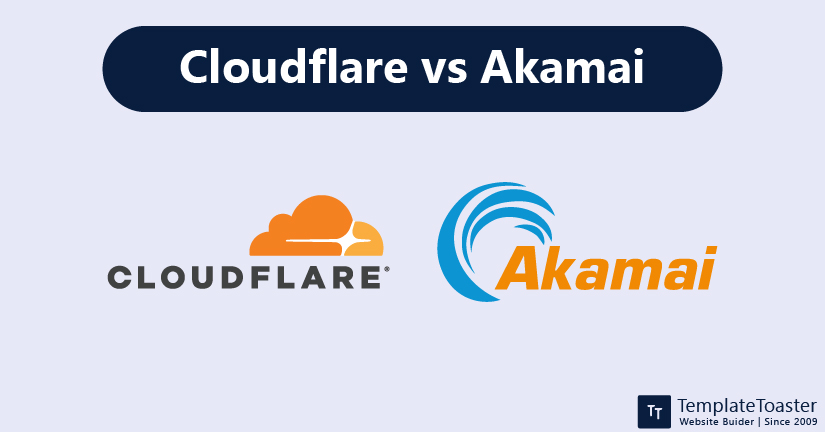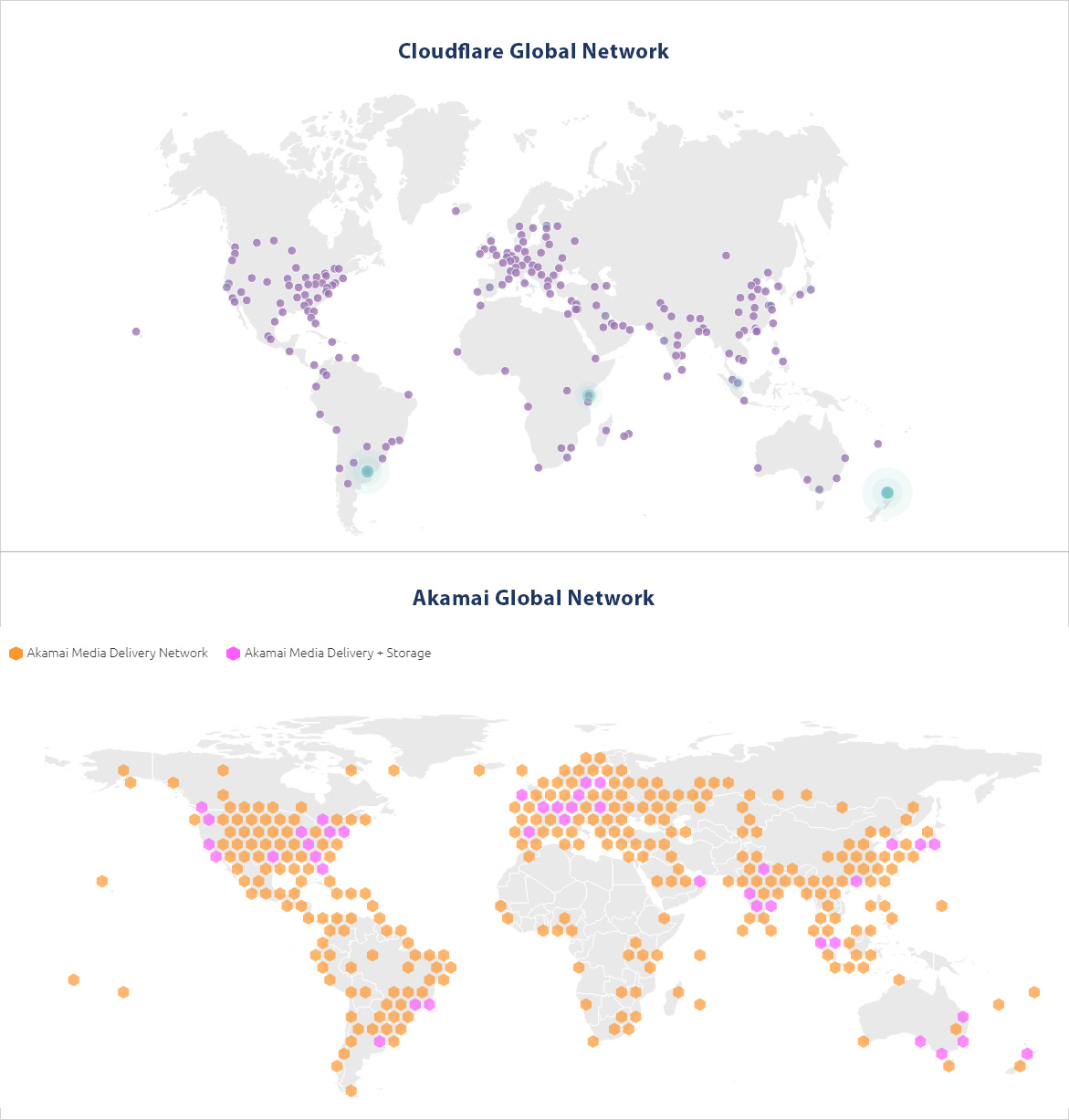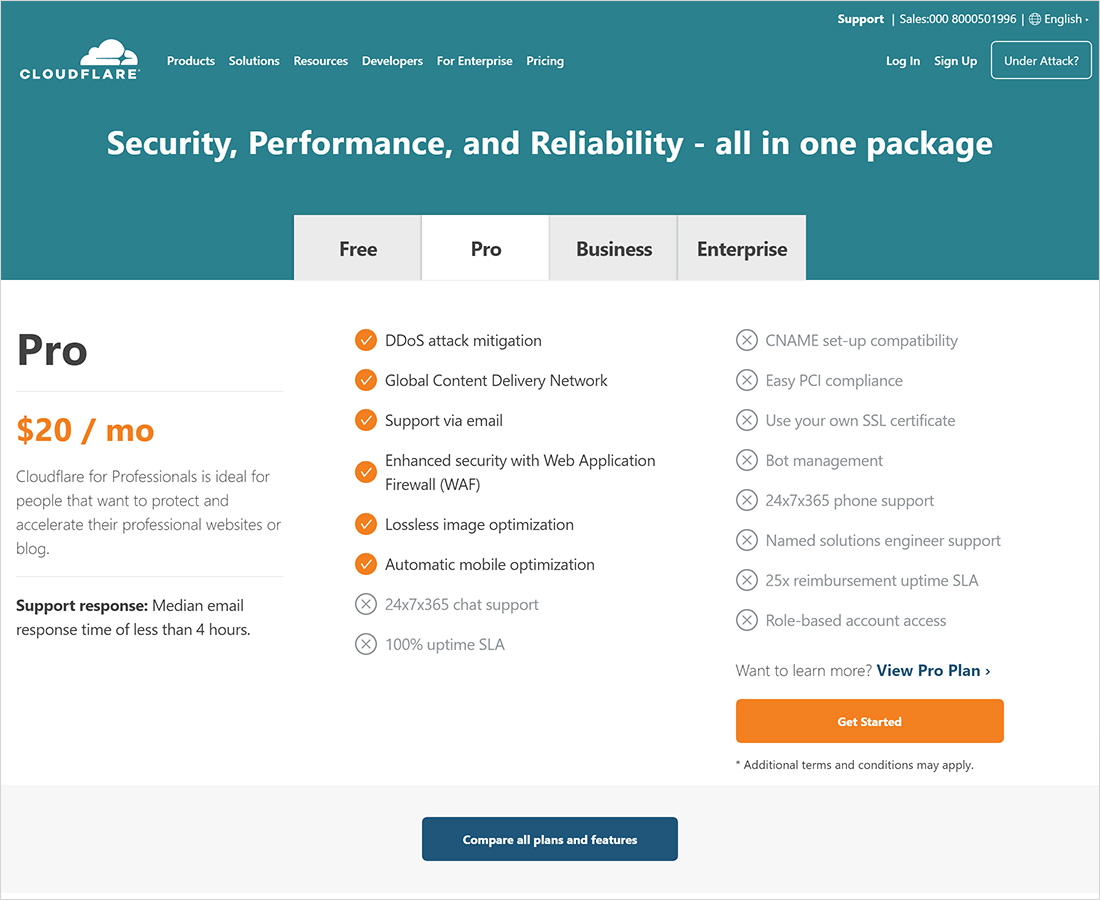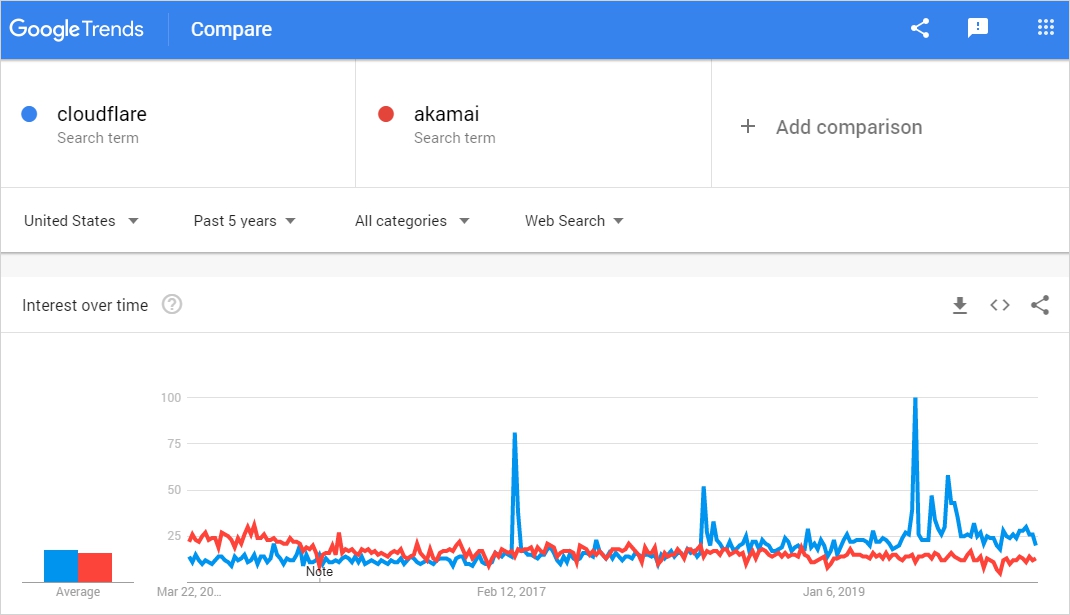Difference between Cloudflare and Akamai

Content Delivery Network (CDN) is a popular term and the market is also getting hyped up. And the hype is quite fair considering a CDN can offer a ton of features which can make it difficult for a newbie to select a CDN service provider. Therefore, to help you out with this confusion, here is a comparison of two big players in the CDN industry, Cloudflare vs Akamai. Both of them are effective tools, however, one can select based on their specific requirement. I will state the strengths and weaknesses of Cloudflare vs Akamai differences. Have a look at their pricing, features, geographic distribution, and other factors of these platforms to decide!
Why CDN? Because speed. Website speed matters, in fact, it matters a lot. 1) Because people are not keen on waiting for a website to load. 2) Your website has only 2 seconds to load if it doesn’t load within 2 seconds, the user will abandon it. Therefore, CDN is the need of the hour. It is a network of servers placed in different locations globally for the faster delivery of the content. It can deliver text, image, video, audio, download files, and any form of digital media. Basically, it reduces the travel distance for data that results in reduced latency. Whenever a user requests something from a certain website, the closest server of the CDN responds to that request with the cached (pre-fetched) data. That way, the data travel distance reduces, the website loads faster, and the origin server never overloads.
What is Cloudflare?
Cloudflare is the most popular CDN, known for its unique performance capabilities along with a strong focus on security. The infrastructure is built from scratch and was originally intended to offer security. However, its algorithm increases the performance of the websites as well. Hence, Cloudflare now has a global infrastructure built with next-generation, high performing equipment, without any legacy software or hardware. Cloudflare is easy to set up with machine learning capabilities, which enables the infrastructure to learn, adapt, and integrate constantly to meet the future needs of the emerging internet scenario.
Features of Cloudflare
- 100% uptime guarantee: Even if the origin server is down due to any reason, the static features of the website will still be accessible to the users.
- Ease of use: They offer a pretty straightforward method to sign up and operate on Cloudflare. All you need to do is simply use your CDN by employing their services and modifying their DNS.
- Analytics: You get comprehensive analytics to trace your most recent data. It traverses on a 24-hour interval with the free plan and a 15-minute interval with paid plans.
- High-end Security: With its high-end algorithm, it offers advanced security against DDoS attacks.
Pros and Cons of Cloudflare
| Pro | Cons |
|---|---|
| Cloudflare is easy to set-up, thanks to its highly responsive UI and easy management interface. | Possesses the threat of Man-in-the-middle certificate forgery. |
| Highly secure and affordable | It can introduce unsolvable roadblocks in some circumstances as it requires users to enter captcha at each site using Cloudflare for suspected visitors. It ultimately lowers the usability of the web. |
| Works efficiently with both static and dynamic content | Technical support is not available for free plans. Moreover, even with the paid plans, technical support is rather slow. |
| Offers npm auto-update | Cloudflare offers the ‘log access’ feature to the enterprise plan only. However, you can’t get instant access to it and have to contact support. |
| Allows anyone to add or update libraries | Cache control is ineffective and lengthy. |
| Can be integrated with other CDNs easily | You need to manually identify the attack and press ‘I’m under attack’ to enable layer 7 protection. |
| Offers powerful Page Rules | |
| With railguns, it allows up to 140% performance increase | |
| Offers SSL encryption for all its sites | |
| History of handling some of the largest DDoS attacks successfully. |
What is Akamai?
Akamai was founded in 1998 by a group from MIT, and is one of the oldest CDN providers. It serves some of the notable internet brands like Facebook, Adobe, Twitter, etc. No wonder, it accounts for a large portion of the world’s web traffic. It holds a variety of CDN related patents. With an intelligent cloud computing platform, built on top of 200,000 servers in around 110 countries, it is the largest CDN network out there til date.
Features of Akamai
- Caching: It caches and compresses the dynamic content as well, which provides your end-users with quick download rates.
- Route optimization: it works like a GPS for users. As soon as a user visits a site, it starts hunting for the closest accessible server and offers a durable and secure fetching system.
- Pre-Fetching: it works in the background with the objective of offering a better web experience. When data experiences extreme demand, it pre-fetches that data to offer accelerated download speeds.
- Service-level agreement: Akamai serves some of the internet giants as it serves with a quality service and performance. Be assured to have availability and performance agreements to guarantee excellent service.
Pros and Cons of Akamai
| Pro | Cons |
|---|---|
| Akamai has the largest PoPs presence around the world. | 30-day long free trial available. However, no rate list or pricing is given on the official website of Akamai either. |
| It is highly customizable and you can adjust the means according to your preferences. | Remarkably large CDN structure of Akamai makes it time-consuming for security rules to propagate. |
| With Prolexic’s PLXedge, you can get an additional 2.3 TB of bandwidth dedicated to DDoS attack absorption. | |
| Rate limiting tools are available for controlling traffic segments as per their request rate behavior. | |
| Proprietary WAF to protect against application-layer attacks |
Comparing features of Cloudflare vs Akamai
Cloudflare vs Akamai Performance
To test and compare the performance of Cloudflare vs Akamai CDNs, you have to understand the two work modes, ‘PUSH’ and ‘PULL’. The process of sending all your data over to the CDN is Push. basically, the software layer is responsible for integrating the site with the CDN. once the data is Pushed on to the CDN server, they start responding to the users’ requests with the respective data. On the other hand, Pull is basically when CDN caches your data in the background. When the user happens to ask for data that is not pre-cached, then the CDN pulls that file from the main server and caches it for future reference. Akamai offers 16 packets of TCP connection whereas Cloudflare is limited to 10 packets only.
| Winner: Clearly, Akamai acquires better performance due to larger packets. Does that make Akamai the best out there? Perhaps not. However, it surely gives us some useful insight into each CDN’s structure and configuration. And ‘better performance’ factor is worth considering when it comes to picking one up. |
Cloudflare vs Akamai Location coverage
It is natural to have better output if you sign up to the network with the best coverage in terms of geographical placement. Before opting for a CDN services, do your homework and research their data center locations. You don’t want to pay for service that isn’t even available where your audience is. That being said, Cloudflare is known for its diverse data center locations placed strategically across the world. On the other hand, Akamai has the largest CDN infrastructure with around 216,000 servers in over 120 countries. It is literally everywhere humans exist on this planet.

| Winner: Well, Akamai is clearly a winner here. However, if your most audience is UK or US based, Cloudflare will also work just fine for you. |
Cloudflare vs Akamai Security
With Cloudflare, you get unlimited and unmetered DDoS attack protection. It has a history of combating against the strongest DDoS attacks successfully. Its layered security consists of multiple DDoS mitigation capabilities to prevent service disruptions caused due to bad traffic while making a path for good traffic for smooth flow of services. With its advanced DDoS protection, applications and APIs are highly available and performance while keeping the website up always. Cloudflare is appropriate for anyone looking for advanced protection against the strongest DDoS attacks.
On the other hand, with Akamai, you get Prolexic PLXedge route that offers broad and rapid protection against network and application layer DDoS attacks as well. This solution is designed to stop DDoS attacks in the cloud, before letting them reach the origin server and applications. Prolexic can efficiently mitigate even the largest and most complex attacks considering its global platform of high capacity scrubbing centers managed by experienced security experts. Moreover, it is capable of generating early warnings of potential attacks.
| Winner: When it comes to security, Cloudflare is the ultimate winner. It was originally intended to offer advanced security to the websites by stopping scammers from harvesting emails off a website. Moreover, Cloudflare recently fought against a DDoS attack that exceeded 300 Gbps, which was deemed as “largest publicly announced DDoS attack in the history of the internet” by the New York Times. |
Cloudflare vs Akamai Pricing
Cloudflare offers flat priced as well as custom plans. It’s three main plans: Free, Pro, and Business are available for $0, $20, and $200 respectively. Whereas, they also offer ‘Enterprise’ plan, which can be custom-tuned for maximum performance on enterprise-level. However, Akamai doesn’t even provide any information regarding its pricing on its official website. You need to contact their sales team to get a quote. It is presumably on the expensive side as it is being said that they go as high as $3500 for 10TB.
| Winner: Cloudflare is obviously the winner. Not only the expenses are showcased publicly but the plans are also charged flatly, eliminating any kind of hidden charges. |
Cloudflare vs Akamai: The comparison table
How much Cloudflare CDN costs?
Cloudflare CDN can cost you somewhere between $0 and $200, depending upon the plan you choose. It doesn’t charge you according to the bandwidth consumption. Three main plans they offer are ‘Free’, ‘Pro’, and ‘Business’ costs $0, $20, and $200 respectively. Have a look at the following image for a detailed pricing breakup-

How much Akamai CDN costs?
We are sorry to inform you that Akamai doesn’t showcase its pricing publicly on its official website. They offer customized services which means the pricing can vary accordingly. One has to contact their sales team to get a quote. However, it is said that they offer rather expensive plans, which can go as high as $3500 for 10TB.
Cloudflare vs Akamai: Which one suits you best and why?
If you are looking for a way to boost your internet services and you are a small or medium business, Cloudflare is your solution. It boosts the web as well as mobile experience. For a newbie, who isn’t really familiar with CDN service should try out the basic Cloudflare plan, available for free. Cloudflare guarantees the availability and security of the application. It is capable of maintaining the fast applications that are flexible and available even when traffic increases unexpectedly or the infrastructure crumbles. Some of the notable brands seeking Cloudflare services are Reddit, OkCupid, Cisco, Massachusetts Institute of Technology, Ello, Zendesk, etc.Here at Templatetoaster website builder you may read Imperva vs Cloudflare, Sucuri vs Cloudflare, Fastly vs Cloudflare, Cloudflare vs Cloudfront, Stackpath vs Cloudflare
Meanwhile, Akamai is known to offer advanced dynamic site accelerator that can successfully increase a website’s performance up to 5 times faster as compared to an average server. If you have a website with higher traffic, with a large number of audience from different parts of the world, you should pick Akamai. Some of the notable brands seeking Akamai services are Facebook, Adobe, Twitter, BuzzFeed, Airbnb, American Idol, Fiat, IBM, MailChimp, Philips, NBA, etc. have a look at how they are trending:
Cloudflare vs Akamai Frequently Asked Questions (FAQs)
What is Akamai?
Akamai is a professional CDN provider founded in 1998 and is one of the oldest CDN providers out there. It serves some notable internet giants like Facebook, Twitter, etc. They have the largest and most diverse CDN network.
How much Akamai CDN costs?
Akamai doesn’t showcase their pricing publicly, however, it can go as high as $3500 for 10TB, presumably. You need to contact their sales team for pricing information.
What is Cloudflare?
Cloudflare is a well known CDN provider, liked by entry-level and startups. It was founded in 2009 and has emerged immensely.
How much Cloudflare CDN costs?
It offers three basic plans:
- Free Plan: $0
- Pro Plan: $20
- Business Plan: $200
It also offers ‘Enterprise’ plan for custom services on enterprise-level.
Does Akamai have any free plans?
No, they don’t have any free plan but they do offer a free trial for a limited time period. To continue their services after the given time period, you need to pay them.
Does Cloudflare have any free plans?
Yes, they offer a ‘Free’ plan with some basic features. You can use those services as long as you want. ‘Free’ plan is unmetered and unlimited.
Cloudflare vs Akamai- which CDN provider is best for me?
It totally depends on the type and size of your website. If you you are a small to medium business and your website is having standard content with moderate traffic mostly from the US or UK, Cloudflare CDN is best for you. However, if you are large business with lots of funds and your website is having advanced content with immense traffic from different parts of the world, then you should pick Akamai CDN. Check out google page speed to check site performance.
Related reading
Build a Stunning Website in Minutes with TemplateToaster Website Builder
Create Your Own Website Now




Cloudflare seems like more recommendable than Akamai. Thanks for sharing the post!
Indeed, Clouflare is more popular cdn and more reliable
Can you suggest me alternative to Cloudflare? Now i am using Cloudflare but want to shift to other cdn
Hello, StackPath is an awesome CDN. You can totally replace CloudFlare with StackPath
What did you mean when you said CloudFlare can be integrated with any other CDN?
Pricing plans for CouldFlare are better than Akamai. Thanks for sharing the post
Very nice post. Akamai is more reliable than CloudFlare.
True, Akamai has the largest infrastructure and available almost everywhere around the world.
Good post👍
Good post. Akamai is more reliable and totally worth it.
Very insightful post! Thanks for sharing the clear cut comparison.